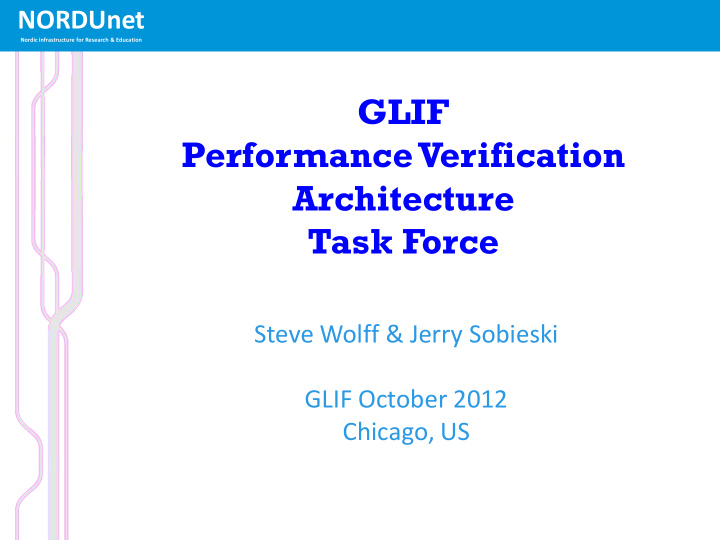



NORDUnet Nordic infrastructure for Research & Education GLIF Performance Verification Architecture Task Force Steve Wolff & Jerry Sobieski GLIF October 2012 Chicago, US
GLIF-PV Task Force NORDUnet Nordic infrastructure for Research & Education • The GLIF PV Task Force is a greenfield effort to define an architecture for end to end verification of light path services, and a strategy for automated fault localization, mitigation, and recovery – Secure, scalable, “industrial strength” – Leverage the emerging NSI Framework • This group is developing recommendations, not standards. – A report/white paper will be the result – Target: 12 months (~Jan 2013 workshop) • GLIF PV TF Charter: http://www.glif.is/working- groups/tech/glif-pv-task-force-charter.pdf
Charter NORDUnet Nordic infrastructure for Research & Education The GLIF End-to-End Performance Verification Architectures task force is chartered to develop recommendations for a deterministic, scalable, and secure architecture for determining the delivered end to end performance characteristics of emerging light path (connection oriented) network services. The Task Force should consider the OGF NSI Framework as the basis for the delivery of these light path services and so the resulting recommendations should support and complement the NSI Framework and may influence that Framework where appropriate. The E2E PVA recommendations may address any/all aspects of service delivery that will affect the predictable, deterministic, and scalable verification of light path performance. … The Task Force should view this as a green field opportunity and not feel compelled to define an architecture that is backward compatible with any existing networks or tool sets. It is of greater importance for the TF to develop a well considered, long term, and comprehensive future facing architecture that will bring greater predictability and reliability to these emerging light path services.
Progress NORDUnet Nordic infrastructure for Research & Education • Sigh… The PV-TF held regular conference calls through Spring… – Discussion centered around existing papers, concepts, and tools… – These were halted in June due to presumably to other priorities among the few participatns. – Times for the calls were set to be convenient for timezones in Asia/Pacific & Europe… but did not seem to help • The discussions had difficulty shedding existing perspectives to think outside the box… • The TF chairs believe the topic is still very real…but a different approach is required.
Current Thinking NORDUnet Nordic infrastructure for Research & Education • Despite a quiver of powerful tools (e.g. perfSONAR), there is still no well defined architecture that provides context for those tools – The range of network services and technologies continues to introduce new challenges for PV. – No common notion of inter-domain…certainly not one that scales beyond the R&E community… – Development continues to add features to these tools – but not necessarily with a long term plan in mind… • We need a near term readout from the PV task force that can guide the thinking, if not the detailed development efforts… – A balance between the the time required to develop and agree to the formalisms of a long term architecture vs – pragmatism of insuring near term efforts have useful guidance
Key Next Step NORDUnet Nordic infrastructure for Research & Education • The TF will deliver the concept paper as specified in the charter. – In advance of at he GLIF Winter workshop in Jan 2013. – The concept paper will be basis for discussion among GLIF participants for next steps in/beyond 2013. – GLIF can [perhaps] decide on a long term strategy for addressing performance verification • The concept paper will meet the original deliverable for the TF.
Discussion? NORDUnet Nordic infrastructure for Research & Education • A long term architecture is still required. – How do we design networks on a global basis that are predictable and that can be verified… – Connection services, P2MP services, multi-layer services, SDN capabilities, mobile/wireless services, cloud capabilities, … • ??
Recommend
More recommend